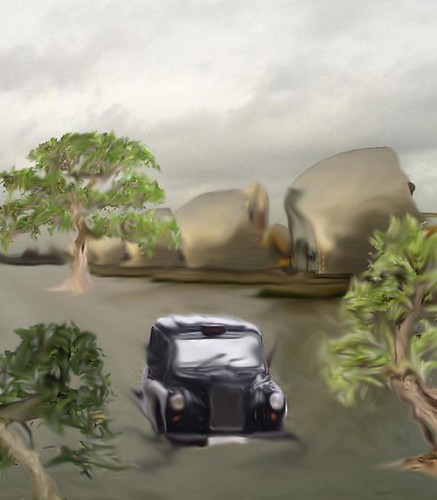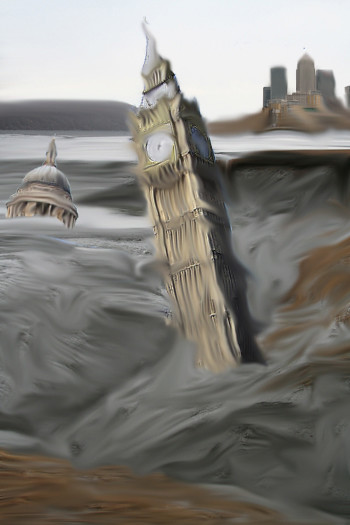My name is Sam Redlark. I am a carrier of the LonB gene which enables me to perceive parts of London that are undetectable to the majority of people. This blog is an account of the Capital as I experience it. I hope that my writing here will encourage those who find themselves in London, whether it is as a visitor, or as a resident, to seek a deeper appreciation of their surroundings. You don’t need to be a LonB carrier to experience the best of the city. All you need to do is open your senses to what is around you.
A sketch of a river...
On Fenchurch Street, Emma Priestnell and I are standing in the middle of what might very well be a dried-up river bed. Around us the early morning flow of commuters from the nearby railway station empties itself into the city, blending seamlessly into the current of office-bound foot traffic. To our right a procession of slow moving cars and buses crawls in fits and starts towards a set of traffic lights. A black taxi rounds a bend and sweeps past us, drawing gracefully up to the curb to drop-off a fare.
For a fractious hour-and-a-half we have been attempting to agree on the course of The Langbourne - the most romanticised and elusive of the Capital’s lost rivers. Now, with the city building momentum in readiness for the working day ahead, we find ourselves run aground on the corner of Mark Lane, struggling to orientate an unsatisfactorily small copy of the London A-Z with an A2-sized reproduction of a map that we recently obtained from the British Library. This is made all the more difficult by the jostling crowd who brush roughly past, threatening to knock these objects out of our hands.
John Stow, the 16th century chronicler of London, mentions the Langbourne as flowing at least in part along Lombard Street. Others imbued with a greater sense of scepticism declare that if these apocryphal waters existed at all, they most likely formed an open sewer that followed the layout of the streets and was certainly manmade in origin.
Adding to the mystery are numerous well-thumbed accounts that give fleeting mention of the river. The most famous of these is a passage that appears in a religious pamphlet that was circulated around the East end of London in the year 1800. The text takes a moralising, puritanical tone, warning of “uncovnetionale baptisms” in what are referred to as “the blasphemouse wateres of the Langbourne.”
It is this and other anecdotes which over the years have added to the current of Langbourne-related speculation among the Capital’s historians and psychogeographers. My friend Charlotte disparagingly refers to the latter “as men of a certain age playing at being Victorian occultists”. When I told her that I intended to write about The Langbourne in this blog, her response was to remark that I wouldn’t get half so dewy-eyed about London’s lost rivers if they were all still flowing above ground.
I suppose that she is right. There is something both attractive and melancholy about things that have become so lost that they threaten to fade altogether from the pages of history and sink into the realms of myth. Although, in reality, the Langbourne is not lost at all, but simply in a state of hibernation awaiting a set of circumstances that will bring it surging back to life:
In 1921 a young man by the name of Christopher Leck researched the river in meticulous detail. Leck had returned from the Battle of the Somme missing his right leg and subsequently found employment with the Islington Spur Historical Society. He later died of TB , aged just 27. When the society disbanded shortly after, his work, which had been largely ignored during his lifetime, was soon forgotten and has only recently been rediscovered.
Leck correctly identified the Langbourne as an airborne river, having observed similar phenomena while serving in France during the First World War. These strange bodies of water owe their existence to a symbiotic relationship that exists between unusual atmospheric conditions, brought about in part by underlying physical geography, and certain species of plant. In Northern Europe the most common sources of airborne rivers are Storm Elms - who exhibit a supernatural hold over weather patterns.
In London’s distant past it would have been possible to chart the course of the Langbourne by plotting the locations of Storm Elms on a map of the city, while taking into account topographical factors such as gradient and obstacles that might impede the flow of running water. These giant trees, now extinct from the British Isles, eject great clouds of pollen directly upwards. The expulsions reach the lower atmosphere where they seeds clouds, causing rain to fall in the vicinity of the tree. By some unknown mechanism Storm Elms are able to encourage lightening to strike them. They conduct these massive jolts of electricity harmlessly into the ground, benefiting from the nitrates that such discharges add to the soil.
The Langbourne in its pomp would have enjoyed a sporadic, seasonal flow, as a series of broken lines rather than a continuous body of water. As Leck describes it: “We must envisage this most peculiar of London’s rivers as a string of puddles which, at certain times in the spring, might combine with one another to form a modest, short-lived torrent.”
The source of the river was probably a great elm that once stood in what is now Duckhead Lane in Clerkenwell. This mighty tree was frequently used as a gallows until the persistent, increasingly heavy rain that fell over the area conspired with the underlying London clay to form a natural moat in the depression around the trunk, making hanging an impractical form of execution. This did nothing to abate the local population’s thirst for capital punishment. Thereafter criminals who had been sentenced to death could expect to have their heads forcibly held under the water that surrounded the tree until they drowned.
Later this body of water came to be known as Redeemers Pond, after Roland Holloway – then the Bishop of London - granted his blessing upon it so that criminals might be baptised and find forgiveness in the eyes of the lord as they were executed. There is a small piece of stained glass in the raised crypt of the nearby Church of Saint Marius depicting this scene.
Branching out from the founding elm were a chain of similar trees that stretched all the way to Wapping. Over the centuries this wooden river has been whittled away. The last of the Storm Elms were killed off by Dutch Elm disease in the 1970s. It seems that while London’s other minor rivers were disappearing underground, where they remain hidden to this day, the Langbourne quietly ascended into the heavens.
A few hours after our fraught, early-morning mapping attempt on the corner of Mark Lane, Emma and I have moved a short distance east to Wapping, where a roughly-laid square of black tarmac forms an incongruous patch over a small section of the paving. This botched repair job marks the location of the last storm elm in London. A victim of Dutch Elm disease, it was felled in 1981. The base of the trunk was initially left in situ because of concerns that removing it might damage surrounding water pipes. It eventually became known Scab’s Stump after the trade union disputes of1986, when striking print workers etched the names anyone of who crossed the picket lines into the wood.
The stump was removed in April 1987 a couple of months after the strikes ended. A report that appeared in The Guardian newspaper around this time mentions it being loaded into the back of a police van and taken away.
“It’s a shame that no one ever thought to count the rings,” says Emma as we throw ourselves into the pointless task of measuring the dimensions of the tarmac.
In the opalescent sky above our heads a marbled vein of grey cloud, sketches-out the course of a long dead river.
NEXT... The go anywhere river


